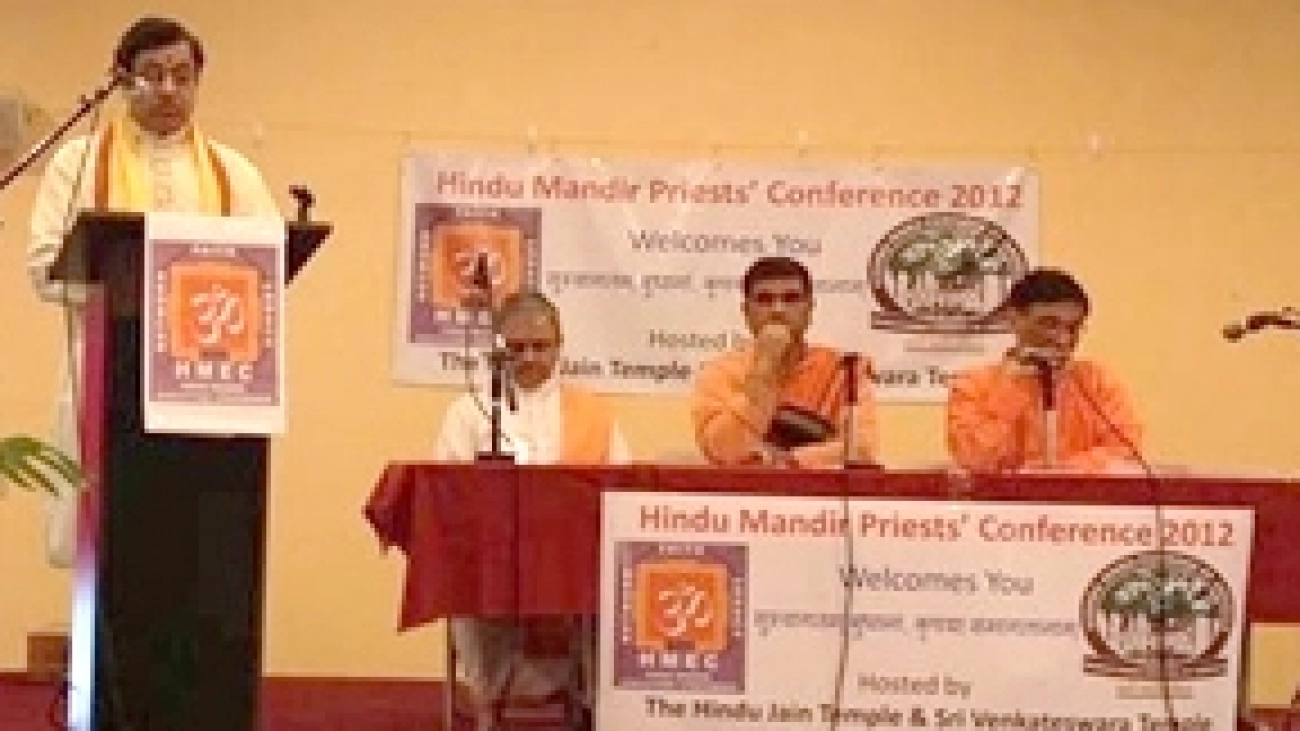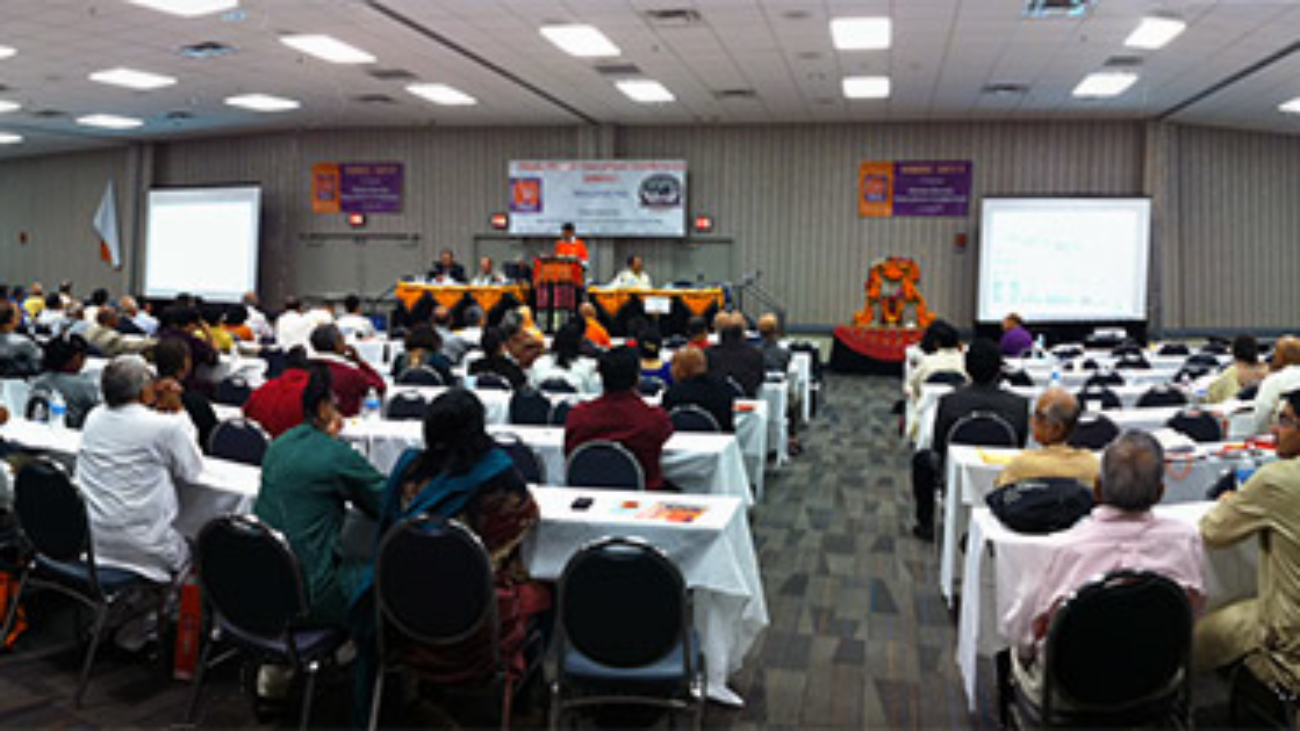Hindu Mandir Executives’ Conference (HMEC)
2ND HINDU MANDIR PRIESTS’ CONFERENCE-NY
May 31 – June 1, 2013
Media Statement
The 2nd Hindu Mandir Priests’ Conference concluded today at the Shri Surya Narayan Mandir at 92-17 172nd Street, Jamaica, NY 11433, amidst joyful expressions of congratulations and handshakes for a highly successful event. “It was a highly informative two days”, was the general refrain.
Following the success of the 1st Priests’ Conference held in Pittsburgh, PA last year, the Organizing committee which was comprised of seasoned HMEC sevaks and members of the local Queens, NY Hindu community, justifiably felt a strong sense of accomplishment by Saturday evening. The Conference was hosted by the Shri Surya Narayan Mandir, in collaboration with the Bhavaanee Maa Mandir, the New York Sanatana Mandir and the United Community Mandir.
The Inaugural Session of the Conference got underway on the evening of Friday May 31 at 7:00 pm. In attendance were more than 130 Hindu devotees, Pandits and Swamis. First, the more than 50 Priests in attendance joined in chanting the Ganesha Atharvashirsha, and then Pandit Ram Hardowar, the Spiritual Leader of the Shri Surya Narayan Mandir extended a warm welcome to all the participants.
The stage was now set for the presentations by the erudite speakers who followed. As the audience listened in rapt attention, the speakers made very thoughtful presentations that covered the challenges facing Priests in the community by Amrutur Srinivasan, the work of the USA Pandits’ Parishad in Guyana and here in the USA by Pandit Parasram, and Swamini Svatmavidyananda’s talk on Devotion, Dharma, Prayer and the Priesthood. The Arya Spiritual Center’s Dharmacharya Pandit Ramlall also spoke about the challenges facing the Hindu in hostile societies.
Saturday started at 6:00 am with yoga, pranayama and devotional singing by young Hindus of the community. After a mouthwatering breakfast served up by the host Mandir, it was back to the serious business at hand. There followed six business sessions ably emceed by youthful Sarika Persaud, assisted by rotating moderators who introduced the various speakers.
The sessions covered topics such as Priests’ Role: Issues & Concerns; Community’s issues & Concerns: Devotees’ & Executives’ Inputs; Sharing resources, the GOTO Group; and Education & Training. The appreciative audience was treated to some very scholarly and passionate presentations covering issues as varied as the role of Priests and their assimilation in the North American society to Hindu Chaplaincy in the University setting, and continuing education and skill development strategies.
In the third session dealing with Community’s issues and concerns, young Aneesh Bairavasundaram stole everyone’s hearts with a polished presentation of “My story: Growing up in a Priest’s family”. Aneesh spoke about the expectations of parents for young Hindus “to blindly follow rituals” laid down by their elders, and that in the “North American context, blind faith is looked down on”. As this young man walked away from the podium, he was treated to loud and prolonged applause for the simple and articulate manner in which he shared his story.
One outstanding feature of this conference was the number of youthful Hindus who made presentations. In addition to Aneesh, there was also Austin Ayer who spoke about the training available at universities in the Maharishi Organization, Devi Mehotra who spoke about the Hindu Students Council at Yale University, and Dr. Anand Ramnarine, who called for a “national Hindu Voice, as a means of solidifying our Hindu identity.”
There were lively Q&A segments after some sessions, which demonstrated that the members of the audience shared strong concern about the topics and presentations, and confirmed the need for this Conference to be organized on a regular basis. The scholarly presentations should find a place on the desk of every serious Hindu Leader. They would prove to be very valuable in devising strategies to resolve difficulties faced by our priests and the devotees they serve.
After all the presentations, the participants unanimously approved 2 resolutions for action:
• Recognizing the need to enhance communication among priests in North America with the sole object of building a Dharmic Bridge between priests and the community they serve, resolves to establish a Pandit Sabha, a communication network.
• That the Conference Committee resolves to resolve to develop a Priests Training Workshop Model that includes development of a Guide Book.
At the close, Dharmacharya Rishi B. Misir of the Federation of Hindu Mandirs, Inc. and the USA Pandits’ Parishad thanked the Conference Committee for its vision and dedication to solving Hindu issues by organizing the event.
It was a conference with all of the ingredients that one could hope for. Brilliant and well received presentations were made by Swamis, Pandits, Mandir Executives, and our Youths, all sharing their perspective on every conceivable issue facing the Hindus in North America. Yes, it was a highly successful 2nd Hindu Mandir Priests’ Conference!
HMEC is an an initiative of World Hindu Council of America (VHPA).
Vishwa Hindu Parishad (World Hindu Council) of America (VHPA), founded in 1970 and incorporated in the state of New York in 1974, is an independent, nonprofit, tax- exempt and volunteer-based charitable organization serving the needs of Hindu community in USA. It aims to build a dynamic and vibrant Hindu society rooted in the eternal values of Dharma and inspired by the lofty ideal of Vasudhaiva Kutumbakam, i.e. the entire creation is one family.










